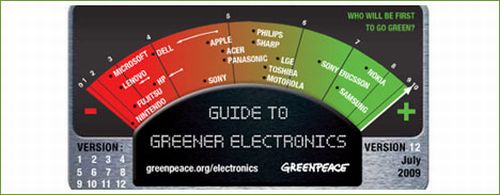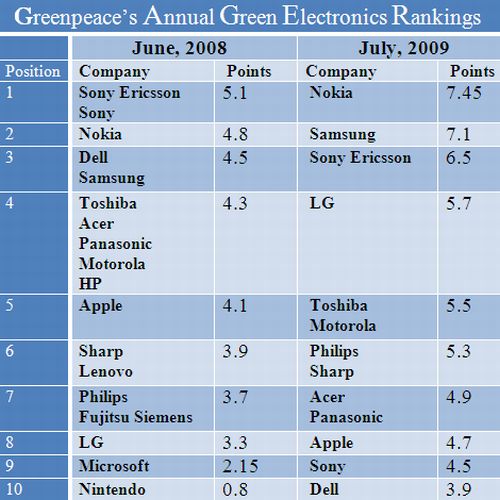
Greenpeace International has just released its Guide to Greener Electronics wherein Nokia enjoys the top ranking. It is quite heartening that the cellphone manufacturers are realizing their responsibilities toward the environment and have put up great show this time. Samsung, Sony Ericsson and LG Electronics follow Nokia while taking the second, third and fourth positions respectively.
The PC makers, on the other hand, are adorning the lowest positions due to their neglect of substantial environmental policies and reluctance to cut down on emissions.
Even after a year, Nintendo still enjoys a comfortable last spot.
How the point tally looks:

1) Nokia’s comprehensive voluntary take-back program in 84 countries enabled it to lead the tally. It also has started instructing its customers on recycling its products.
2) Samsung strikes a perfect balance in reducing greenhouse gas emissions and maintaining continuous growth. Samsung has discarded the use of PVC, and has introduced BFR-free models of mobile phone. It enjoys the second position.
3) Sony Ericsson has shown tremendous progress in settling energy issues. Placed third, it suffers.
4) LG Electronics’ commitment to ban PVC totally in household appliance models by 2014 has improved its rankings from eighth to fourth. Its introduction of halogen-free new models of mobile phones keeps it just below Sony Ericsson.
5) Toshiba cuts the GHGs plans to control the absolute reduction at a level of 1.96 million tons by FY2012. Moreover, it successfully launched new LCD TVs with Energy Star compliance.
It shares the fifth position with Motorola, who purchases 15% of its energy from renewable sources and looks forward to increase this to 20% by 2010 and 30% by 2020. It reports that all newly designed Motorola mobile phone chargers exceed the new Energy Star v.2.0 requirements for standby/no-load modes.
6) Philips moves from seventh to sixth place with an improved score of 5.3 points. Philips commits itself to work towards developing IPR based recycling systems. Philips also collects e-waste in Europe and shows commitment towards its take-back program.
Sharp also holds the sixth position for its TVs meet the latest Energy Star. Sharp’s worldwide energy consumption owes it to renewable energy sources.
7) Acer and Panasonic jointly hold the seventh position. While the former rules the PC market in introducing almost PVC vinyl plastic and brominated flame retardants (BFRs) free systems, the latter reports to the latest Energy Star energy efficiency standards for external power supplies and TVs.
8) Apple is placed eighth for all its products are now free of PVC and BFRs.
9) Sony seems to be worst affected since it topped the tally last year. It suffered because:
– It reports to eliminate PVC and BFRs by March 2011 whereas the time limit cannot be extended beyond FY2010 under any circumstances.
– It failed to support Individual Producer Responsibility.
– Didn’t do well to extend recycling program beyond North America.
– Didn’t form policies to tackle greenhouse gas emissions.
10) Finally, same is the case with Dell too. The PC giant backtracked on its commitment to eliminate PVC and BFRs in all its products by the end of 2009, nor does it have any future programs to do so.
Guide to Greener Electronics:
It is hailed as the green text that reflects the green commitments of the electronic companies. It shows how theses companies have framed policies on recycling, toxic chemicals and the climate change. It also displays their efforts to reduce and nullify carbon emissions and carbon-footprints. Still, the major criteria are elimination of the hazardous substances and recycling the obsolete products. After evaluating them out of 30, companies finally score marks out of 10 for simplicity.

